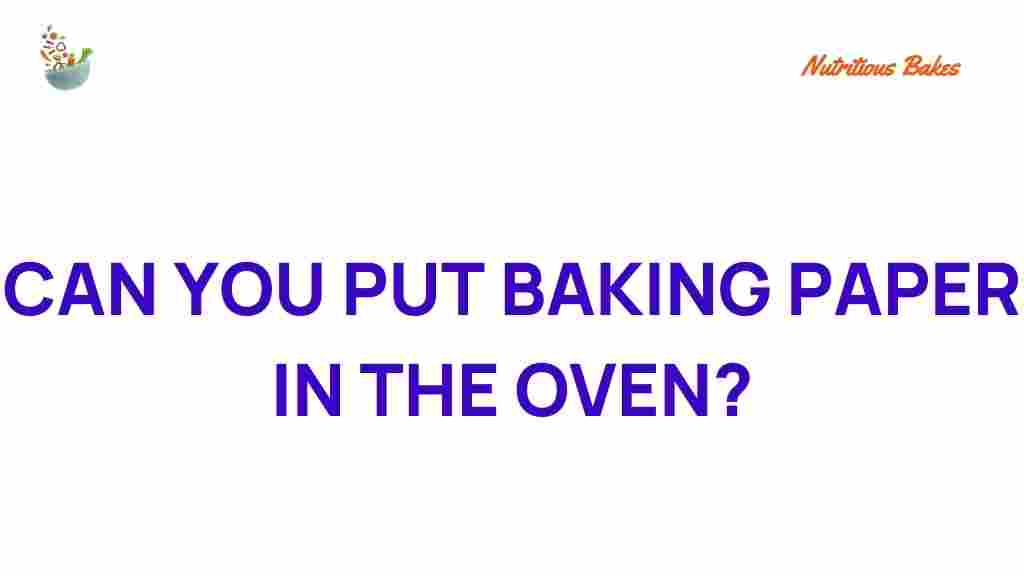The Surprising Truth: Can You Really Put Baking Paper in the Oven?
When it comes to baking, having the right tools and materials is essential for achieving the perfect dish. One item that often comes up in the kitchen is baking paper. But can you really put baking paper in the oven? In this article, we will explore the safety of using baking paper in the oven, discuss its heat resistance, and provide valuable kitchen tips that every home cook should know. Whether you are a novice baker or an experienced chef, understanding the use of baking paper is crucial for effective food preparation and baking techniques.
What is Baking Paper?
Baking paper, also known as parchment paper, is a heat-resistant, non-stick paper that is used in the kitchen to line baking sheets and cake pans. It offers a convenient surface that prevents food from sticking and makes cleanup much easier. Here are some key features of baking paper:
- Heat Resistance: Baking paper can typically withstand temperatures up to 420°F (215°C), making it suitable for most baking tasks.
- Non-stick Surface: Its non-stick quality means that baked goods can be easily removed from the paper.
- Versatility: Baking paper can be used for a variety of cooking techniques, including roasting, baking, and even wrapping food.
Is Baking Paper Safe to Use in the Oven?
Yes, baking paper is safe to use in the oven as long as you follow a few guidelines. Its design allows it to withstand high temperatures without burning or releasing harmful chemicals. However, there are a few important points to keep in mind:
- Check the Temperature Limit: Always check the manufacturer’s instructions for the maximum temperature limit of the baking paper you are using.
- Avoid Direct Flame: Do not place baking paper directly over a flame or let it touch the heating element of the oven.
- Use for the Right Purpose: Baking paper is primarily designed for baking and roasting; avoid using it in broiling situations.
How to Use Baking Paper in the Oven: A Step-by-Step Guide
Using baking paper in the oven is straightforward. Here’s a step-by-step guide to ensure you use it effectively:
- Preheat Your Oven: Before you start baking, preheat your oven to the appropriate temperature for your recipe.
- Prepare Your Baking Sheet or Pan: Cut a piece of baking paper to fit your baking sheet or pan. You can crumple it slightly to make it easier to fit.
- Line the Pan: Place the baking paper on the sheet or pan, ensuring it covers the bottom and sides if necessary. For extra security, you can lightly grease the pan before placing the paper down.
- Add Your Food: Place your dough, batter, or other food items on top of the baking paper.
- Bake as Directed: Follow your recipe for cooking times and temperatures.
- Cool and Remove: Once baked, allow your food to cool slightly before lifting it off the baking paper for easy serving.
Tips for Using Baking Paper Effectively
Here are some additional kitchen tips to maximize the effectiveness of baking paper:
- Store Properly: Keep your baking paper in a cool, dry place to maintain its quality.
- Reuse When Possible: If the baking paper is clean after use, you can often reuse it for another baking session.
- For Steaming: Baking paper can also be used to create parchment packets for steaming fish or vegetables.
Troubleshooting Common Issues
Even with the best techniques, you might encounter some issues while using baking paper. Here are some common problems and solutions:
- Burnt Baking Paper: If your baking paper burns, check the temperature setting on your oven and ensure it is within the recommended range.
- Sticking Food: If food sticks to the baking paper, it may be due to insufficient grease or the type of food being used. Consider using a silicone baking mat as an alternative.
- Paper Crinkling: If the baking paper crinkles during baking, this is normal and should not affect your recipe.
Alternatives to Baking Paper
While baking paper is a fantastic option, you might want to explore alternatives for certain situations:
- Silicone Baking Mats: These reusable mats provide a non-stick surface and can withstand high temperatures.
- Aluminum Foil: Foil can be used for certain baking tasks, but it is not non-stick unless greased.
- Greased Pans: For some recipes, simply greasing the pan may work, yet it may not provide the same ease of removal as baking paper.
Conclusion
In summary, baking paper is a safe and effective tool to use in the oven for a variety of baking techniques. Its heat resistance, non-stick properties, and versatility make it an essential item in any kitchen. By following the guidelines for its use and being mindful of its limitations, you can enhance your food preparation experience and achieve great results in your baking endeavors. So, the next time you reach for that roll of baking paper, you can do so with confidence, knowing you are making a smart choice for your culinary creations.
For more kitchen tips and to explore essential cooking techniques, visit our kitchen essentials guide. If you want to learn more about the science of baking and its best practices, check out this external resource.
This article is in the category Tips and created by NutritiousBakes Team
